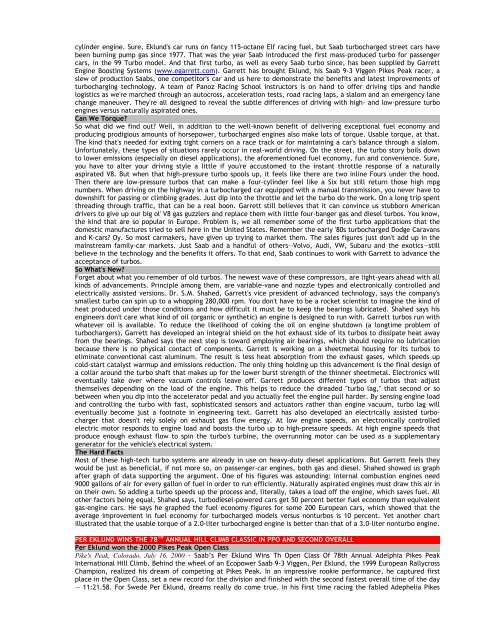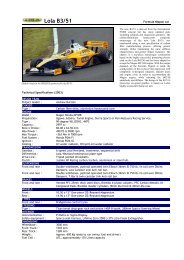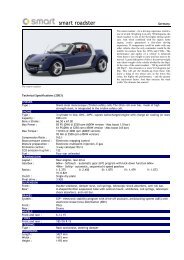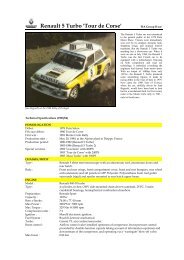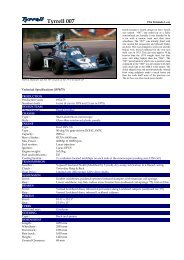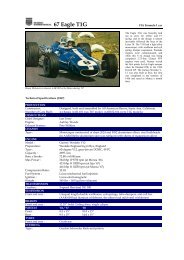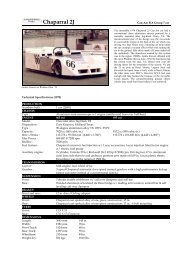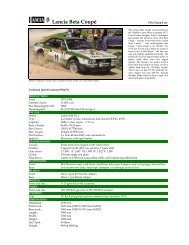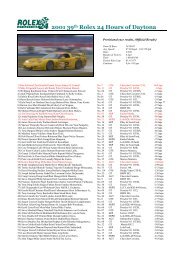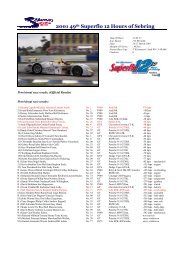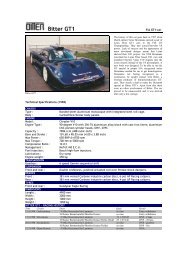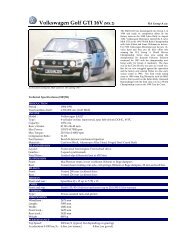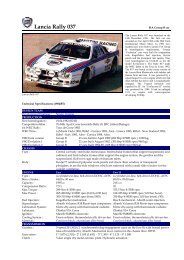Saab 9³ Viggen Pikes Peak - Motorsports Almanac
Saab 9³ Viggen Pikes Peak - Motorsports Almanac
Saab 9³ Viggen Pikes Peak - Motorsports Almanac
Create successful ePaper yourself
Turn your PDF publications into a flip-book with our unique Google optimized e-Paper software.
cylinder engine. Sure, Eklund's car runs on fancy 115-octane Elf racing fuel, but <strong>Saab</strong> turbocharged street cars have<br />
been burning pump gas since 1977. That was the year <strong>Saab</strong> introduced the first mass-produced turbo for passenger<br />
cars, in the 99 Turbo model. And that first turbo, as well as every <strong>Saab</strong> turbo since, has been supplied by Garrett<br />
Engine Boosting Systems (www.egarrett.com). Garrett has brought Eklund, his <strong>Saab</strong> 9-3 <strong>Viggen</strong> <strong>Pikes</strong> <strong>Peak</strong> racer, a<br />
slew of production <strong>Saab</strong>s, one competitor's car and us here to demonstrate the benefits and latest improvements of<br />
turbocharging technology. A team of Panoz Racing School instructors is on hand to offer driving tips and handle<br />
logistics as we're marched through an autocross, acceleration tests, road racing laps, a slalom and an emergency lane<br />
change maneuver. They're all designed to reveal the subtle differences of driving with high- and low-pressure turbo<br />
engines versus naturally aspirated ones.<br />
Can We Torque?<br />
So what did we find out? Well, in addition to the well-known benefit of delivering exceptional fuel economy and<br />
producing prodigious amounts of horsepower, turbocharged engines also make lots of torque. Usable torque, at that.<br />
The kind that's needed for exiting tight corners on a race track or for maintaining a car's balance through a slalom.<br />
Unfortunately, these types of situations rarely occur in real-world driving. On the street, the turbo story boils down<br />
to lower emissions (especially on diesel applications), the aforementioned fuel economy, fun and convenience. Sure,<br />
you have to alter your driving style a little if you're accustomed to the instant throttle response of a naturally<br />
aspirated V8. But when that high-pressure turbo spools up, it feels like there are two inline Fours under the hood.<br />
Then there are low-pressure turbos that can make a four-cylinder feel like a Six but still return those high mpg<br />
numbers. When driving on the highway in a turbocharged car equipped with a manual transmission, you never have to<br />
downshift for passing or climbing grades. Just dip into the throttle and let the turbo do the work. On a long trip spent<br />
threading through traffic, that can be a real boon. Garrett still believes that it can convince us stubborn American<br />
drivers to give up our big ol' V8 gas guzzlers and replace them with little four-banger gas and diesel turbos. You know,<br />
the kind that are so popular in Europe. Problem is, we all remember some of the first turbo applications that the<br />
domestic manufactures tried to sell here in the United States. Remember the early '80s turbocharged Dodge Caravans<br />
and K-cars? Oy. So most carmakers, have given up trying to market them. The sales figures just don't add up in the<br />
mainstream family-car markets. Just <strong>Saab</strong> and a handful of others—Volvo, Audi, VW, Subaru and the exotics—still<br />
believe in the technology and the benefits it offers. To that end, <strong>Saab</strong> continues to work with Garrett to advance the<br />
acceptance of turbos.<br />
So What's New?<br />
Forget about what you remember of old turbos. The newest wave of these compressors, are light-years ahead with all<br />
kinds of advancements. Principle among them, are variable-vane and nozzle types and electronically controlled and<br />
electrically assisted versions. Dr. S.M. Shahed, Garrett's vice president of advanced technology, says the company's<br />
smallest turbo can spin up to a whopping 280,000 rpm. You don't have to be a rocket scientist to imagine the kind of<br />
heat produced under those conditions and how difficult it must be to keep the bearings lubricated. Shahed says his<br />
engineers don't care what kind of oil (organic or synthetic) an engine is designed to run with. Garrett turbos run with<br />
whatever oil is available. To reduce the likelihood of coking the oil on engine shutdown (a longtime problem of<br />
turbochargers), Garrett has developed an integral shield on the hot exhaust side of its turbos to dissipate heat away<br />
from the bearings. Shahed says the next step is toward employing air bearings, which should require no lubrication<br />
because there is no physical contact of components. Garrett is working on a sheetmetal housing for its turbos to<br />
eliminate conventional cast aluminum. The result is less heat absorption from the exhaust gases, which speeds up<br />
cold-start catalyst warmup and emissions reduction. The only thing holding up this advancement is the final design of<br />
a collar around the turbo shaft that makes up for the lower burst strength of the thinner sheetmetal. Electronics will<br />
eventually take over where vacuum controls leave off. Garrett produces different types of turbos that adjust<br />
themselves depending on the load of the engine. This helps to reduce the dreaded "turbo lag," that second or so<br />
between when you dip into the accelerator pedal and you actually feel the engine pull harder. By sensing engine load<br />
and controlling the turbo with fast, sophisticated sensors and actuators rather than engine vacuum, turbo lag will<br />
eventually become just a footnote in engineering text. Garrett has also developed an electrically assisted turbocharger<br />
that doesn't rely solely on exhaust gas flow energy. At low engine speeds, an electronically controlled<br />
electric motor responds to engine load and boosts the turbo up to high-pressure speeds. At high engine speeds that<br />
produce enough exhaust flow to spin the turbo's turbine, the overrunning motor can be used as a supplementary<br />
generator for the vehicle's electrical system.<br />
The Hard Facts<br />
Most of these high-tech turbo systems are already in use on heavy-duty diesel applications. But Garrett feels they<br />
would be just as beneficial, if not more so, on passenger-car engines, both gas and diesel. Shahed showed us graph<br />
after graph of data supporting the argument. One of his figures was astounding: Internal combustion engines need<br />
9000 gallons of air for every gallon of fuel in order to run efficiently. Naturally aspirated engines must draw this air in<br />
on their own. So adding a turbo speeds up the process and, literally, takes a load off the engine, which saves fuel. All<br />
other factors being equal, Shahed says, turbodiesel-powered cars get 50 percent better fuel economy than equivalent<br />
gas-engine cars. He says he graphed the fuel economy figures for some 200 European cars, which showed that the<br />
average improvement in fuel economy for turbocharged models versus nonturbos is 10 percent. Yet another chart<br />
illustrated that the usable torque of a 2.0-liter turbocharged engine is better than that of a 3.0-liter nonturbo engine.<br />
PER EKLUND WINS THE 78 TH ANNUAL HILL CLIMB CLASSIC IN PPO AND SECOND OVERALL<br />
Per Eklund won the 2000 <strong>Pikes</strong> <strong>Peak</strong> Open Class<br />
Pike's <strong>Peak</strong>, Colorado, July 16, 2000 - <strong>Saab</strong>’s Per Eklund Wins Th Open Class Of 78th Annual Adelphia <strong>Pikes</strong> <strong>Peak</strong><br />
International Hill Climb. Behind the wheel of an Ecopower <strong>Saab</strong> 9-3 <strong>Viggen</strong>, Per Eklund, the 1999 European Rallycross<br />
Champion, realized his dream of competing at <strong>Pikes</strong> <strong>Peak</strong>. In an impressive rookie performance, he captured first<br />
place in the Open Class, set a new record for the division and finished with the second fastest overall time of the day<br />
— 11:21.58. For Swede Per Eklund, dreams really do come true. In his first time racing the fabled Adephelia <strong>Pikes</strong>


